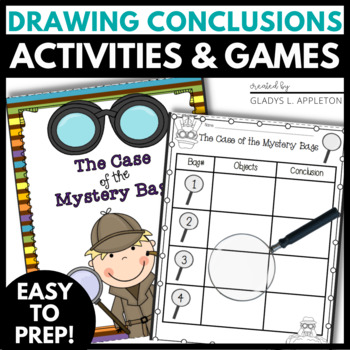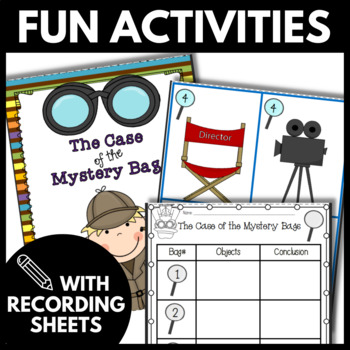Drawing Conclusions and Detective Inferences Interactive Activities & Games
- PDF
What educators are saying
Description
Are you looking for engaging drawing conclusions activities that will get your students up and moving?! These drawing conclusions activities are a great way for students to practice their reading comprehension skills, especially when creating inferences.
Drawing conclusions can be a difficult concept to teach elementary students. The printable and interactive activities in this resource can be used with any text or passage. Drawing conclusions is like solving a mystery, so the detective theme makes it really fun and would be perfect for a fun room transformation!
This hands-on unit full of interactive lessons will keep your students thinking and learning all about drawing conclusions!
What is included in this product?
- Drawing Conclusions Anchor Chart
- Graphic Organizers for Drawing Conclusions
- The Case of the Mystery Bags (A Drawing Conclusions Cooperative Learning Activity)
- Who am I? Animal Riddles (A Drawing Conclusions Activity)
- Drawing Conclusions and Writing Activity
How do I use this product?
The drawing conclusions activities in this packet includes an anchor chart, interactive activities to use as an opening activity each day or with cooperative groups throughout your unit, printables for students to use to draw conclusions in a story, graphic organizers and mystery bags. They can be used as:
- opening activities to the unit
- cooperative groups
- independent work
- small group instruction
- whole group instruction
Your students will love learning all about drawing conclusions with these interactive literacy activities!
Are you worried about prepping these activities? Don't be! This mini-unit is quick and easy to prep...just print the student pages and you'll be ready for a fun and engaging class!
TEACHERS LIKE YOU SAID…
⭐️⭐️⭐️⭐️⭐️ Tonya Z. said, "This is a great resource for drawing conclusions and very easy to set up. Kids loved it!"
⭐️⭐️⭐️⭐️⭐️ Cassie S. said, "This is an awesome resource. It's very easy to set up. My students loved the mystery bags. We did one together as a class and then did the rest in small groups. They were so excited to work together to "solve the mystery"!"
⭐️⭐️⭐️⭐️⭐️ Danielle R. said, "Love using mystery activities in my small group title classes. I love that they can be carried out over a week and keeps them engaged and excited to come to group. "
____________________________________
Do you need other Interactive Reading Lessons? You'll love these:
The Koala Who Could: Interactive Read Aloud Lesson Plans
Spaghetti in a Hot Dog Bun - Interactive Read Aloud Lesson Plans and Activities
____________________________________
Copyright © Gladys L. Appleton.
Permission to copy for single classroom use only.
Please purchase additional licenses if you intend to share this product.
Let's connect and be friends! Find me here:
Would you like to SAVE on new resources? Just click the GREEN STAR below my name. This will allow you to follow my store and receive e-mail notifications on freebies and when a new resource is added.
Don’t forget to leave feedback on your purchase to earn TPT credits!





